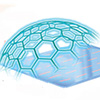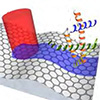Ultrasensitive 3D plasmonic web can detect molecules at the yoctomolar level
 Researchers create a 3D flexible plasmonic web that enables ultrasensitive surface-enhanced Raman spectroscopy, detecting molecules remotely at the yoctomolar level.
Researchers create a 3D flexible plasmonic web that enables ultrasensitive surface-enhanced Raman spectroscopy, detecting molecules remotely at the yoctomolar level.

 Subscribe to our Nanotechnology Spotlight feed
Subscribe to our Nanotechnology Spotlight feed
 Researchers create a 3D flexible plasmonic web that enables ultrasensitive surface-enhanced Raman spectroscopy, detecting molecules remotely at the yoctomolar level.
Researchers create a 3D flexible plasmonic web that enables ultrasensitive surface-enhanced Raman spectroscopy, detecting molecules remotely at the yoctomolar level.
 Neuromorphic antennal sensory system emulates ant antennae, outperforming humans in tactile exploration and magnetic perception tasks.
Neuromorphic antennal sensory system emulates ant antennae, outperforming humans in tactile exploration and magnetic perception tasks.
 Nnew stretchable biomimetic multimodal receptor built with kirigami film engineering and thermoelectric nanomaterials can switch between 2D and 3D modes to detect range of stimuli.
Nnew stretchable biomimetic multimodal receptor built with kirigami film engineering and thermoelectric nanomaterials can switch between 2D and 3D modes to detect range of stimuli.
 Novel spiking neural network architecture processes images using event-driven photodetector circuits inspired by biological vision. Direct optical-to-spike conversion slashes power needs for visual pattern recognition tasks.
Novel spiking neural network architecture processes images using event-driven photodetector circuits inspired by biological vision. Direct optical-to-spike conversion slashes power needs for visual pattern recognition tasks.
 AI vision may become faster cheaper and more human-like with new perovskite synapses These mimic the retina's image processing for incredible efficiency.
AI vision may become faster cheaper and more human-like with new perovskite synapses These mimic the retina's image processing for incredible efficiency.
 Cutting-edge research harnesses butterfly mating behaviors to create a groundbreaking visuochemical integration platform. This bio-inspired hardware, merging visual and chemical data, paves the way for advanced multisensory decision-making in artificial intelligence.
Cutting-edge research harnesses butterfly mating behaviors to create a groundbreaking visuochemical integration platform. This bio-inspired hardware, merging visual and chemical data, paves the way for advanced multisensory decision-making in artificial intelligence.
 Researchers developed modular, self-assembling graphene sensors that enable versatile, reconfigurable wearable health electronics tailored to individuals.
Researchers developed modular, self-assembling graphene sensors that enable versatile, reconfigurable wearable health electronics tailored to individuals.
 An electrically tunable graphene-based biosensor amplified by surface acoustic waves detects ultrathin protein, peptide and polymer layers at unprecedented resolution, even down to the single molecule limit.
An electrically tunable graphene-based biosensor amplified by surface acoustic waves detects ultrathin protein, peptide and polymer layers at unprecedented resolution, even down to the single molecule limit.